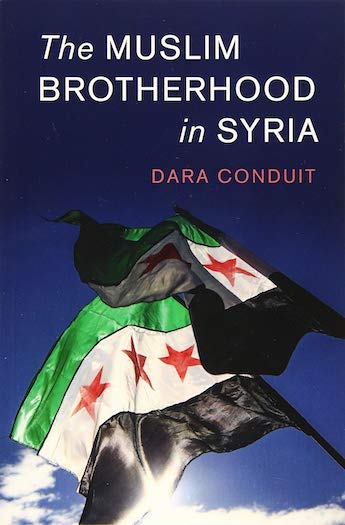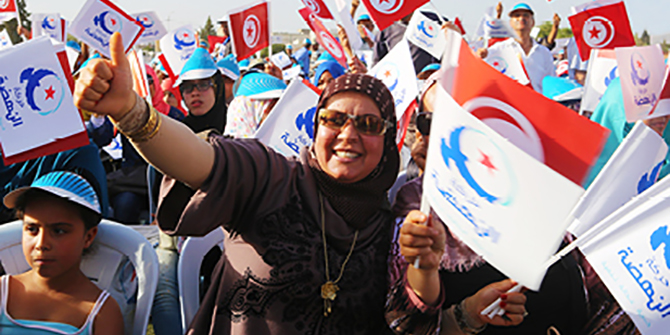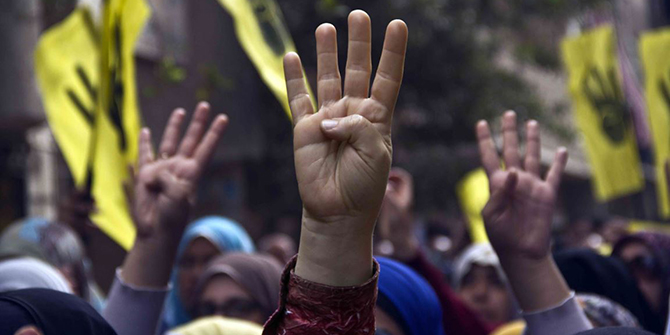by Courtney Freer
As debates continue globally about the role of the Muslim Brotherhood in domestic and transnational environments, Dara Conduit’s book provides much-needed clarity about the history of the Syrian Muslim Brotherhood and its role in shaping the transnational Brotherhood’s response to the uprising that began in 2011. She recognises that the Hama massacre of 1982 is often taken as ‘the definitive example of the group’s character, more instructive than the nearly four decades of organisational history that preceded the event or the three decades that followed’ (5). While the Hama massacre has long been taken as proof that the Syrian Brotherhood was, at its core, violent, Conduit explains that the event was itself ‘an aberration for an otherwise mainstream group’ (7). The book argues therefore that it is the Syrian Muslim Brotherhood’s history, including but not limited to the Hama massacre, rather than its ideology or membership base, which explains its underperformance in the 2011 uprising (7).
Conduit makes the important point that ideology never played a strong role in the Syrian branch. Instead, she identifies three central characteristics of the Syrian Brotherhood that have shaped its character since founding: pragmatism, individualism and ideological flexibility (13–14). She explains that these characteristics are a product of the group’s history: it was created from several jamiyat and was influenced by Salafi and Sufi ideologies (40). This point demonstrates the extent to which each domestic branch of the Muslim Brotherhood, although purportedly following the same broad doctrines, in fact use this ideology in very different ways. Conduit explains that ‘Islamism never formed a major part of the Syrian Muslim Brotherhood’s political agenda,’ describing the Syrian Brotherhood instead as ‘a conservative political party’ (30). This observation begs the question of how we define ‘Islamist’, and how we define ‘Muslim Brotherhood’.
Further, Conduit posits that the Syrian Brotherhood’s decisions were shaped not by its founding principles, but mainly by ‘(1) The group’s founding organisational characteristics of individualism, pragmatism and ideological flexibility; (2) the group’s operating context; and (3) political opportunities’ (65). In fact, since its founding in 1945 or 1946 through incorporating a variety of jamiyat, it was never a tightly knit organisation with party discipline (44). Lacking a strong ideological pull, the Brotherhood held limited appeal to ‘members of the middle and lower echelons of urban and rural society, whose support was captured by socialist and communist groups’ (30).
The group’s constituencies also show how local Brotherhood branches have attracted different segments of society. Unlike in Egypt, for instance, the Syrian Brotherhood had close ties to ulama-traditional classes and with urban merchants and traders (41–2). Because the Brotherhood comprised many members from elite segments of society, it was committed to preserving private property rights, economic liberalism, and a constitution with an ‘Islamic bearing’ (42). Members tended to have a vested interest in the status quo, and so sought to maintain cordial relations with the government (43).
The Brotherhood participated in elections held between 1947 and 1963 and then witnessed a crackdown after the Ba’ath takeover, which led to violence at the end of the 1970s. The 1963 coup altered the Brotherhood’s political behaviour, as it left little room for manoeuvre since there was less space for legitimate political activity (89). The individualistic strain of the Syrian Brotherhood came through, with different members taking on a variety of stances and some more willing to adopt violence than others (97). Notably, it took over 15 years after the Ba’ath takeover for the Brotherhood to adopt violence, demonstrating the group’s hesitation to do so (95). The failure of the Hama uprising hangs over the Syrian Brotherhood to this day, and Conduit suggests there has not been sufficient introspection about it (128–9). Nonetheless, the Brotherhood has not exhibited any inclination toward violence since Hama, which was seen as ‘a tactical rather than an ideological choice’ (129).
Conduit makes the important point that the Muslim Brotherhood managed to survive in exile after Hama not because of the help of fellow Brotherhood organisations, but rather due to other external connections (134). Indeed, she sees the links that the Syrian Brotherhood made abroad, primarily in Iraq and Jordan, as ‘a by-product of its lifelong pragmatism and individualism’ (135). Conduit underlines that the Syrian Brotherhood’s flexibility was importantly largely due to the fact that ‘[t]he Syrian political environment has been hostile to the Brothers for most of the group’s lifetime’ (141). Its ability to internationalise was critical to its survival as well as to its return in 2011, but was not enabled by the international Muslim Brotherhood network (145).
Having covered the Brotherhood’s history in the first portion of the book, the second part focuses specifically on the uprising that began in 2011 and the Syrian Brotherhood’s role therein. She highlights the issues that hindered Brotherhood leadership of the movement. First, the Brotherhood had a reputation for its willingness to make political compromises – particularly with the regime – dating back to the 1980s, which hurt its credentials as part of the opposition. In particular, the organisation’s decision to freeze opposition during the 2008–9 Gaza war was damaging to its credibility as a committed part of the opposition (162).
Second, the Brotherhood struggled to clarify its ideology and thus to distinguish itself from other parts of the opposition; it continued emphasising its commitment to democracy and non-violence and relied on texts of its founding leader Mustafa al-Sibai (39). As Conduit explains, ‘while the group viewed its congruence with the path of Mustafa al-Sibai as a sign of its ideological integrity, to some this unwavering commitment to the founding fathers is a source of stagnation that relegates it to the past and prevents innovation’ (176). Further, the individualism that had always been a characteristic of the Syrian Muslim Brotherhood led to a plurality of voices and opinions when it came to the uprising (178).
Third, the Syrian Brotherhood lacked a base within Syria – in part due to reputational damage (178–9) and also due to its inability to provide a political platform that offered political solutions for Syria in 2011 (180–1). Some of its leadership also appeared to alienate the youth, although the revolt involved large numbers of young people (187). Many members of the Brotherhood also had the reputation as being ‘elite and out of touch with the Syrian population’ (183). Unable to take a leading role in the uprising itself, then, the Syrian Brotherhood sought to rebuild links with the population by providing humanitarian aid, and these contributions were significant until states like Qatar, Saudi Arabia and Turkey became involved (180–1) – states, notably, with which the Brotherhood had historically had ties (188).
Conduit also traces the Brotherhood’s reticence to become involved in the conflict as it became militarised. Indeed, particularly after the experience at Hama, ‘[a]ny oversteps on the battlefield would be interpreted as indicative of the group’s brutality, a power-grab and confirmation of their reputed unsuitability for political leadership’ (200). The Brotherhood formalised its approach in late 2011 at a meeting in Saudi Arabia, where it decided against forming militias – a decision that was reversed in mid-2012. The leadership also approved of ‘a decentralised approach, which allowed members the freedom to respond on their own accord, with their leadership’s implicit sanction. This meant that the Brotherhood’s response to the armed uprising was characterised by two tiers: formal decisions made by the central Muslim Brotherhood leadership and informal activities undertaken by the group’s base’ (203–4). The decentralised activities of Brotherhood members boosted their reputation but also tended to blur the lines between the group and individuals (217). The Brotherhood, recognising that its strengths were political rather than military (212), also fundraised for humanitarian aid and sent members to Syria to provide political and religious education (211).
Conduit highlights it was not the Brotherhood’s ideological platform, but rather its political history – largely one of co-optation and repression – which hindered its ability to play a larger role in the uprising (66). This conclusion demonstrates the way in which Brotherhood movements are fundamentally localised, rather than parts of a cohesive transnational whole. As Conduit explains, ‘[h]istory coloured every decision that the Brotherhood made after 2011. The memory and fear or past mistakes, the dispersed leadership and organisational structures, the ongoing internal paralysis that prevented the group’s regeneration, its closeness to foreign states but not to its own people on the ground – these are all conditions of its history’ (198). The Brotherhood’s political baggage therefore hindered the Syrian group’s political future.
Conduit’s book is an important study of a Brotherhood movement that demonstrates the extent to which local context matters: there is no single Muslim Brotherhood, nor is the transnational structure able to sustain these individual organisations. Domestic politics matter, and Islamists are able to learn and develop politically, depending on political opportunity structures, as Conduit points out. It may have been helpful for Conduit to engage more deeply with some of the literature on contentious politics in authoritarian states to make her conclusions more explicitly generalisable, but the book, as it stands, is a very important contribution to the study of Syria and to the study of the Muslim Brotherhood and Islamism more broadly – particularly in a militarised environment.







